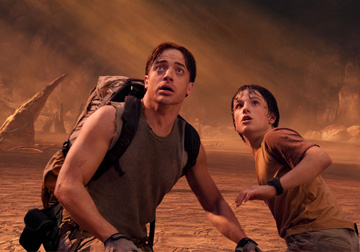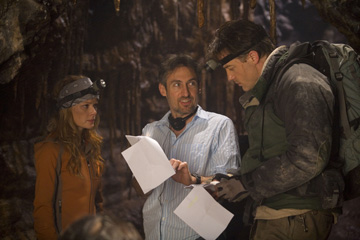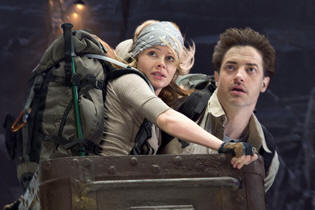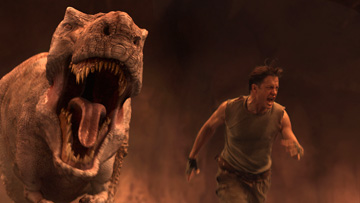Even an old action flick veteran like Brendan Fraser (well, he's not
really old, but he will be 40 this year) is thoroughly fascinated by
the digital technology that has birthed a 21st century version of
3-D filmmaking. Of course, it's no wonder Fraser's enamored of this
new technology since he is the star of Journey to The Center of
The
Earth – the first full-length, live-action feature shot in
digital 3D. That's not to say that the Indianapolis-born actor needs
the new variation on the medium to prove he is a hit-maker.
After all, Fraser quarterbacked the first Mummy film into a
mega-hit that has now become a tentpole franchise with another
sequel, The Mummy: Tomb of the Dragon Emperor, coming out
later this summer. But even before he had those films, he had been a
comedic star shepherding along such kid-friendly films as Encino
Man, Airheads, and George of the Jungle into hits. Of
course, he has an Oscar-friendly, indie film side, having starred in
such critically acclaimed films as Crash, Gods and Monsters
and The Quiet American as well.
The saga of making a modern digital 3-D version of Frenchman Jules
Verne's 1864 sci-fi classic Journey to the Centre of the Earth
really began with HDTV camera technology developed by
director/producer James Cameron for his own productions. Obviously,
it has roots in all the 3-D concepts before it, when shooting a 3-D
movie in film was expensive and dependent on special projectors to
show the films. That's why, in recent years, 3-D films have been
mostly non-feature length docs shown in IMAX theaters. Once digital
technology made it possible to manipulate the final results in
computers without needing film, having enough theaters using digital
projectors became the primary constraint in releasing digital 3-D
pictures – until now.
Indie filmmaker Paul Chart (American Perfekt), originally
signed to write and direct the picture, penned the original script.
After the producers decided to shoot in 3-D, Chart left, afraid that
it would become something more for a theme park rather than be the
epic action-adventure he envisioned. Special effects specialist Eric
Brevig (a visual effects Oscar nominee for Hook and Pearl
Harbor) was brought in to direct his first feature and the
script was heavily retooled to emphasize the new format.
Fraser became so passionate about this movie that he offered script
revisions and a commitment that led him to become an executive
producer on the film as well as its lead – the seismic scientist and
maverick adventurer Trevor Anderson. He amply explained all this in
a very recent roundtable session.
 With such action film experience, what do you do to prepare for
doing a movie like this 3-D production?
With such action film experience, what do you do to prepare for
doing a movie like this 3-D production?
Let me start from the beginning. I got the script. It was based on
Verne's classic tale, Journey to the Centre of the Earth.
Verne was arguably science fiction's creator. We've seen the film
before; it's slightly, as the British say, "daft" [laughs]. I
say that with affection. I didn't arch my eyebrow at it, I didn't
turn my nose up to it because I don't know an actor who doesn't like
to work. But the cover letter to the script said that this [version]
was going to be shot in 3-D and I was like "What, huh?" I thought
3-D was when you wore red and blue glasses and watched the movie and
it made you a little bit queasy after a while and you went home and
said, "Why did I spend my money for that? Anyway, let's get back to
paying taxes and stuff." I wasn't sure what the technology held,
[but] I was hooked [on the idea of it]. But I hadn't read the book
as a teenager in school like I was supposed to [laughs]. So I
went to a bookstore got the last copy of an anthology of Verne and
thumbed through it as fast as I could. [But there were a few
problems with the script I read so] I realized
that the answer was right there in the book, like they say, in the
world of the film.
So what did you think was the problem?
All you needed to do was flip-flop the relationships [from how they
were described in the original book]. The professor has a nephew;
he's his research partner. They have this theory, he's slightly mad
but they must go and find out [if it is true]. Actual classic
mythology has said that Mt. Sneffels [a volcano with a glacier
covering its summit in western Iceland] is a portal to the center of
the earth. Changing the gender of the guide [was also necessary]. I
think, depending on who it was published by, [in Verne's original
Journey...] he was like either Hans or Hortz, or something like
that. So we had the character become Hannah [Anita Briem]. In this
version, you have this misfit trio of oddball characters who aren't
going to get along that well. Textbook screenplay writing has it
that if you bring those people together to see them win and succeed
by the end of the story. That's what we had to go for. I pitched my
idea to Eric [Brevig]. I showed up to the meeting with my copy of
the book, and the screenplay, and said, "Look, I just read this and
the screenplay." I also collect cameras, because I'm a wannabe nerd,
and I had with me my stereopticon [a mid 19th century projector with
two lenses that created the effect of 3-D for still images] just to
prove that I knew about 3-D too [laughs].
 I gave him my ideas that were basically to change the relationships
around a little bit. It's all writing. All the set pieces [in the
original Journey...] were great; I don't know about that, but
those can stay in place, those are the big ticket items, but in the
end, between you, me, and the tape recorders, we wound up writing it
ourselves. Eric later told me he could have kissed me on the lips
for it, because it solved all the problems of the challenges they
would have been come up against with how to get this thing green-lit
and going. I brought everything I had to a studio and talked to Cary
[Granat, producer and co-founder of Walden Media], and said "Look,
you've got to make me a producer. I put my neck out [laughs]
and he said, "Okay I will do it." And I'm like, "Alright what do I
do?" They were like, "Well, take it seriously." A lot of those
producer credits go out there to actors and they're kind of, vanity
titles. It's what you make of it, and in this, I was able to bring
the considerable knowledge that I have learned in [the last few
years]… At ShoWest [the theatrical exhibitor's trade show] they gave
me a film achievement award even though it took me 20 years
to get it [laughs].
I gave him my ideas that were basically to change the relationships
around a little bit. It's all writing. All the set pieces [in the
original Journey...] were great; I don't know about that, but
those can stay in place, those are the big ticket items, but in the
end, between you, me, and the tape recorders, we wound up writing it
ourselves. Eric later told me he could have kissed me on the lips
for it, because it solved all the problems of the challenges they
would have been come up against with how to get this thing green-lit
and going. I brought everything I had to a studio and talked to Cary
[Granat, producer and co-founder of Walden Media], and said "Look,
you've got to make me a producer. I put my neck out [laughs]
and he said, "Okay I will do it." And I'm like, "Alright what do I
do?" They were like, "Well, take it seriously." A lot of those
producer credits go out there to actors and they're kind of, vanity
titles. It's what you make of it, and in this, I was able to bring
the considerable knowledge that I have learned in [the last few
years]… At ShoWest [the theatrical exhibitor's trade show] they gave
me a film achievement award even though it took me 20 years
to get it [laughs].
How has your journey – so to speak – been to this point?
Interesting. I think in many ways I'm just reaching my stride, I
feel like I have a lot left to do. I'm excited to see what the
future holds, because clearly this movie is the first of its kind in
history. Arguably, this movie can be an innovation in cinema
technology that is on par with when the moving image was fused with
an audio track. People said it will never take, no one will go. Oh
well, sorry, it kind of did and then color film came to the screen
they were like, "Why do you want to see it in color [laughs]."
Then television was invented and again they went "We listen to
radios." Then they invented TV dinners and people didn't go to the
cinemas anymore. Then someone got an idea and it was like, "I know,
3-D." We've had this bizarre stereoscopic image gimmick around for
over a 100 years then let's put that back in the screen and people
will come back to the theaters and we won't go out of business. They
did that and people came back; it was a little hokey but in the end
they learned to just make better movies and people will come. Oh
there was a gag I hope you got it, maybe you didn't, in the movie,
for those in the 3-D know, when Trevor opens the box he pulls out
this wooden thing and says, "I have no idea what this is" and throws
it over his shoulder. It's the stereopticon; it's what people used
to put an image in front of and they go like, "Oh cool, the Grand
Canyon. Oooh, naughty pictures from France." I just want you to know
that all of these advances have come to a point now that, I've
learned so much with visual imagery and working with CGI, it went
from 0 to 10 during my career. The 1992 film Encino
Man – go ahead let it out, just get it out now [laughs] –
I assure you, did not have one processed shot in it at all. It was a
camera, tripod, a script, and three actors, well, two really, and
Pauly Shore [laughs again], and me with a squirrel attached
to my head. That was it. That was a teen film.
 Films like that aren't made for teens any longer. We've advanced so
much, technologically speaking. I mention this is because, if you
think of the number of ways we can receive our media and the
platforms on which they are delivered, they are displayed in
auditoriums, on canyon walls, and even on your i-Pod. What's missing
is the magic that happens with the communal experience of being on a
stage and telling a story and having people captivated at what
you're doing, and they are doing it together. When you go to a
movie, there's a barrier, something distancing between you and that
experience. The experience of this technology, and this film, being
the first of its kind, is important because the star of the film is
the experience itself. So you like the movie, or say you don't like
the movie, fair enough... apples and oranges. You kind of can't say
you didn't have a good time seeing what I saw. If you do maybe you
have one eye [laughs]. The three dimensions are something
that has a "boo" scare to it. Something comes out at you,
thankfully, it's used judicially. The audience feels like we are all
in this together and the better you can have depth of field that
just goes on and on and on, depending on how much the studio ponyed
up for some talent CGI artist to create a background that is just
crisp.
Films like that aren't made for teens any longer. We've advanced so
much, technologically speaking. I mention this is because, if you
think of the number of ways we can receive our media and the
platforms on which they are delivered, they are displayed in
auditoriums, on canyon walls, and even on your i-Pod. What's missing
is the magic that happens with the communal experience of being on a
stage and telling a story and having people captivated at what
you're doing, and they are doing it together. When you go to a
movie, there's a barrier, something distancing between you and that
experience. The experience of this technology, and this film, being
the first of its kind, is important because the star of the film is
the experience itself. So you like the movie, or say you don't like
the movie, fair enough... apples and oranges. You kind of can't say
you didn't have a good time seeing what I saw. If you do maybe you
have one eye [laughs]. The three dimensions are something
that has a "boo" scare to it. Something comes out at you,
thankfully, it's used judicially. The audience feels like we are all
in this together and the better you can have depth of field that
just goes on and on and on, depending on how much the studio ponyed
up for some talent CGI artist to create a background that is just
crisp.
So what was your favorite scene?
One of my favorite sequences in the film is the raft sequence, with
the storm fish and animals and the creatures are leaping from the
water and we are battling them valiantly. During that scene it felt
like I could see the curvature of the inner earth of the ocean.
There's something poetic about that. I've never seen that before.
What about the people who can't see it in 3-D if only have 1-D
projectors available?
Get on an airplane go to the United States, England. Is what I would
say, you really want to see the experience of it in 3D. I haven't
seen the film as a "Flattie" let's call it [laughs]. [Now
I've] coined that phrase first [laughs]. Hopefully the film
still works on a standard projection; at the end of the day that's
what it's all about. You want people to walk away feeling they had
fun, "I just killed two hours, yeah." It's an important industry
question that was asked. I don't know if I have the answer. Between
the studios, the theater owners, they are all watching this film to
see how it does because it comes down to conversation; [that is if
people talk about it]. The delivery system is reels. Technology
we've had for a hundred years. Anybody working in the popcorn
counter can walk in, flip a switch, and make it go. Truth is it's
pretty much the same thing with digital; you just press a button.
But getting the theater owners to convert from analog to digital is
something I want you to ask Eric Brevig about. He could give you a
better answer then I can, but the answer is to be decided to be
determined. I had a meeting with Reel D this morning and there are
1400 theaters in the United States alone. We made this movie two
years ago. It would have been ready last year, but the number of
theaters was only half of what we have now. Why come out at a time
when there aren't enough screens for people to see the film as it's
conceived and shot and created and delivered to them in a way that
it really wasn't meant to be? It's like I said before, it's about
being there to enjoy it.
 What was it like acting in a completely CGI action film?
What was it like acting in a completely CGI action film?
The quick answer to that is: bruises and ice packs [laughs].
Strapped into a little metal thing on hydraulics attached to
something called a gimbal that smashed me around [laughs].
You worked on a few films in Montréal. Is that where this was
shot?
Well, yeah, I worked there twice. Journey to the Center of the
Earth was shot at Mel's Studios, a great facility with great
crews; motivated and friendly, it's a nice environment. And I shot
another movie there called *cough cough* Mummy 3 [laughs].
Will you take your kids to watch this movie?
They may be a little too young…. One of my favorite things to do is
to go see the families and their kids, and see little kids reach out
and try to catch a blue bird and then see their dad go "Ahhh!"
[laughs] When the dinosaur leaps out at them. See the little kid
go, "Yeah!" [laughs again]. They love it you know.
And next... How much of a dream is it to be in a GI Joe
film?
[A dream] come true. I am a GI Joe.
Who do you play?
I can't say but it's not Gung Ho… Don't
believe everything you read on the internet.